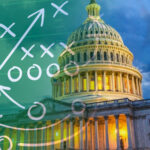Man of Steel?
With many thanks to Danielle DiMartino Booth for last week’s interview, lets pick up where she left off and address some of the implications of her conclusions.
Prior to 2014 (the same year foreign central banks stopped net purchases of US Treasurys), the relationship between US deficits and the unemployment rate was crystal clear. When the unemployment rate increased, so did the US deficit as tax receipts took a hit. Conversely, when the unemployment rate dropped, tax receipts increased and the deficit shrank. In some instances, the US budget even registered a surplus.
That was America prior to 2014, but it just isn’t so anymore. Since 2014, the fiscal problem has deteriorated to the point where the deficit as a percentage of GDP consistently worsens even when the unemployment rate is dropping, and even when the US economy is at full employment. This disconnect is historically unprecedented. The deficit/GDP ratio is growing so fast regardless of a low unemployment rate that the US literally can’t afford a recession that spikes the unemployment rate, nor can it afford the higher-for-longer interest rates that blow out the debt via the rapidly expanding interest component. We now appear to have crossed the Rubicon on debt and deficits, as well as the effective use of higher interest rates. Jay Powell, with his hand on the fed-funds-rate lever, now has the ability to either accelerate (higher rates) or delay (lower rates) the day of fiscal reckoning. That puts pressure aplenty on his broad shoulders, which could manifest as soon as next week’s FOMC policy meeting.
Making matters worse, Jay Powell is now starting to lose support for his higher-for-longer policy even from within a circle of previously hawkish and supportive central bankers. Last week it was Federal Reserve Governor Christopher Waller who said the time for an interest rate cut “is drawing closer.” This week, in a Bloomberg Op-Ed titled “I Changed My Mind. The Fed Needs to Cut Rates Now,” former president of the Federal Reserve Bank of New York Bill Dudley said; “I’ve long been in the ‘higher for longer’ camp, insisting that the US Federal Reserve must hold short-term interest rates at the current level or higher to get inflation under control. The facts have changed, so I’ve changed my mind. The Fed should cut, preferably at next week’s policy-making meeting.” Dudley continued to say, “Although it might already be too late to fend off a recession by cutting rates, dawdling now unnecessarily increases the risk.”
Another consequence of a significant Fed pivot to rate cuts would likely be a weaker US dollar. A weaker dollar, all-else-equal, would support US manufacturing and support the stock market. Both would help tax receipts, and—by extension—both would help ease the deficit and buy time on the countdown to the fiscal crisis.
Perhaps not coincidentally, a weaker dollar also clearly appears to be a major policy objective of the potential Trump/Vance administration whose campaign has gained significant momentum of late. In a recent interview with Bloomberg, Trump made it crystal clear that he wants a weaker US dollar to help support US manufacturing competitiveness. As Trump put it, “we have a big currency problem because the depth of the currency now in terms of strong dollar/weak yen, weak yuan, is massive. And I used to fight them, you know, they wanted it weak all the time… I said, if you weaken it anymore [vs. the dollar], I’m going to have to put tariffs on you… [but now] the spread is the biggest and I think they said 38 years [weakest Japanese yen vs. the dollar in 38 years.] That’s a tremendous burden on our companies that try and sell tractors and other things to other places outside of this country. It’s a tremendous burden.”
JD Vance has sung the same tune. Given the tendency for reserve currency status to keep the dollar strong relative to other currencies, Vance openly questioned Fed Chair Powell in March of 2023 over the wisdom of the dollar’s reserve currency status going forward: “Americans have enjoyed one of the greatest privileges of the international economy for the last nearly eight decades, a strong dollar that acts, of course, as the world’s reserve currency… I think in some ways you can argue that the reserve currency status is a massive subsidy to American consumers, but a massive tax on American producers. Now, I know the strong dollar is sort of a sacred cow of the Washington consensus, but when I survey the American economy and I see our mass consumption of mostly useless imports on the one hand and our hollowed out industrial base on the other hand, I wonder if the reserve currency status also has some downsides and not just some upsides as well.”
Vance went on to connect a strong dollar—via its negative impact on US manufacturing—to a national security risk. He pointed out that with the strong dollar hollowing out the US industrial base, we may now be overly reliant on foreigners who may not even be allies (think China) for the supply of certain critical and strategic manufactured goods.
Again, HAI’s point is that, despite still-elevated inflation, there is a growing laundry list of reasons for Jay Powell to cut rates, and significant pressure on him to cut rates aggressively.
With the US fiscal situation in mind, HAI’s working assumption is that the Federal Reserve Chair appears to have precious little option but to aim for “close enough and hope for the best” on inflation before being forced—soon—to pivot toward cutting rates in an attempt to avoid a budget-busting recession while simultaneously easing the powder keg that is the rapidly escalating cost of servicing $35 trillion in US government debt.
In other words, HAI expects Powell to begin easing policy, perhaps more significantly than the market currently expects. The pressure on him to do so is impossible to ignore, and mounting quickly. He would have to possess a genuinely heroic streak and be a true “man of steel” to stick gallantly with his higher-for-longer policy, come what may, in steadfast service to his inflation mandate.
Now recall that, in last week’s HAI interview, Danielle appeared to favor an altogether different possibility. She believes a recession is already upon us and that the hard part of the hard landing is incoming just as surely as the hen is in the egg, the flower in the seed. Danielle suggested that, in her view, while Powell would soon begin to cut rates, he would not cut them to zero again.
In HAI’s understanding, Danielle insinuated that Powell would lower rates somewhat as the recession deepens, but keep them stubbornly high, and keep them high enough to act as a “debilitating factor for our US government servicing that debt.” In other words, presumably, Danielle believes that, even at the cost of a prolonged recession and the likelihood of initially accelerating the fiscal crisis, Jay Powell will take it upon himself to discipline D.C. lawmakers (via higher interest rates and “debilitating” interest expenses) into slowing the fiscal train-wreck by forcing austerity in Washington.
HAI truly loves that idea. Furthermore, HAI truly loves the thought of Jay Powell, man of steel, standing firm under immense pressure, on principle, for the greater good. We desperately need that now more than ever throughout government.
That said, while HAI wants to believe it, this author is still somewhat skeptical. Danielle is brilliant, well informed, and a Fed insider. Her view should undoubtedly be considered and taken very seriously. That said, HAI is concerned that the US is already in an acute fiscal situation that may well have already crossed the Rubicon. Given the advanced state of the problem at this point, it seems an extremely risky strategy to attempt to solve a fiscal crisis by significantly exacerbating one. In other words, to use “debilitating” interest expenses as a weapon to rein in “unsustainable” beltway fiscal spending—especially when a recession looms that will tempt lawmakers to employ aggressive new stimulus spending—seems likely to backfire spectacularly and dramatically accelerate the crisis rather than avert it.
To understand the profundity of Danielle’s view of Powell’s likely path forward, consider conclusions from a recent white paper called “Laying a robust macro-financial foundation for the future,” from the Bank of International Settlements (BIS). According to the BIS, “The environment of higher interest rates further weakens fiscal positions that are already stretched by historically high debt levels… Though financial market pricing points to only a small likelihood of public finance stress at present, confidence could quickly crumble if economic momentum weakens and an urgent need for public spending arises on both structural and cyclical fronts. Government bond markets would be hit first, but the strains could spread more broadly, as they have in the past.”
In other words, according to the BIS, if we get into a recession, look out. A consequently perceived “urgent need for public spending,” if acted upon, could crush confidence, crush the bond market, and pop the sovereign debt bubble—the mightiest bubble of all. Furthermore, as the BIS suggests, if the bond market cracks, expect the collateral damage to spread more broadly and a vicious cycle to ensue. In that case, further economic and market weakness would drive lower tax receipts, increased deficits, and further spiral the fiscal black hole.
Alternatively, if, in the event of recession, Powell’s still higher rates and resulting “debilitating” interest expenses do restrain lawmakers from throwing money at the “urgent need for public spending,” then we may have to settle for a recession without recovery—or what Dr. Lacy Hunt calls “a depression.”
Believe it or not, HAI doesn’t like to be the skeptical pessimist in the face of potential hope. HAI is incredibly optimistic in the long run, but sympathizes with the purported words of Winston Churchill; “The Americans will always do the right thing—after they have exhausted all the alternatives.”
Unless Powell is every bit the man of steel Danielle suspects he is, HAI just isn’t sure Americans believe they’ve exhausted all the alternatives yet. Until we have more evidence that the strategy of kick-the-can-down-the-road no longer holds sway in D.C., HAI expects policymakers to buy time with interest rate cuts, weak dollar policies, and fiscal support despite still elevated inflation. As such, from an allocation standpoint, gold continues to shine bright.
Weekly performance: The S&P 500 was down 0.83%. Gold was off 0.75%, silver was crushed by 4.37%. Platinum was off 3.03%, and palladium was off by 1.71%. The HUI gold miners index was lower by 1.30%. The IFRA iShares US Infrastructure ETF was strong, up 2.76%. Energy commodities were volatile and down on the week. WTI crude oil was down 1.88%, while natural gas was off 3.62%. The CRB Commodity Index was off 1.06%. Copper was lower by 2.66%. The Dow Jones US Specialty Real Estate Investment Trust Index was up 0.47%. The Vanguard Utilities ETF was up 1.53%. The dollar index was down 0.05% to close the week at 104.06. The yield on the 10-yr U.S. Treasury was down 4 bps to close at 4.20%.
Have a wonderful weekend!
Best Regards,
Morgan Lewis
Investment Strategist & Co-Portfolio Manager
MWM LLC















